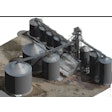

“It’s intended to be an integrated facility that covers almost every aspect of grain handling and related processing,” said Dr. Charlie Hurburgh, professor-in-charge of the Grain Quality Initiative with ISU Extension and Outreach.
“It’ll offer training and research, teaching programs for animal nutrition and feed technology, grain quality, and there will be employee training and onboarding for those already in the industry.”
Hurgurgh said the complex is well on its way to providing education and value to students and the industry, as well as commercial feed, during a GEAPS joint chapter meeting on April 14.
The mill’s slip-formed tower, warehouse and an education center with classrooms and academic facilities are already finished. Most of the feed mill will be completed by fall 2022, but due to supply chain disruptions, some key features will be delayed until next spring.
Hurburgh said a grand opening ceremony with university officials and donors like Todd & Sargent and Sukup may be possible by March or April 2023. He hopes the complex will someday help recruit new talent to the industry.
“It will be open for pre-arranged tours to teach people that grain processing and this industry is not a bad place to work and is certainly important in the whole scheme of agriculture, even though it may not be in the spotlight,” Hurburgh said.
In addition to producing feed for the variety of livestock and animal species raised at ISU, it will also take smaller feed batch orders from nearby integrated farming operations and other companies.
“We’ll be responsible for making the feed for all animal nutrition programs, but probably up to 50% of the output one day may be commercial production for other companies that are feeding research diets in smaller quantities,” Hurburgh said. “It's not our intent to load semi- after semi-truck of feed on a 24-hour-basis, but we’ll handle smaller, more specialized applications.”
Eventually data from the Kent Corporation Complex can help calculate the carbon footprint of grain processing, a largely unknown sustainability factor along the animal agriculture supply chain.
“A unique thing we’ll do is grain dryer performance tests,” Hurburgh said. “This is becoming quite important as carbon footprint data increases in importance. The whole feed mill is instrumented to a much greater extent than a normal feed mill so energy consumption and throughputs can be measured at all points along the way — valuable from both from a teaching and demonstration standpoint and from an energy optimization standpoint.”











